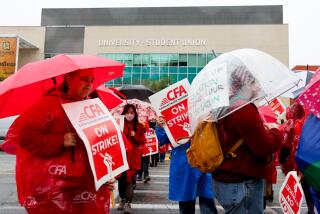Lesson in Anger : Students, Teachers, Administrators at Le Conte School Upset by Slow Progress
- Share via
Shake Gyultrashyan, 15, was so sure that regular classes would resume at Le Conte Junior High School Monday that she studied over the weekend for a test left hanging when teachers went out on strike a week ago.
By Monday morning, however, her hopes dashed by news reports of a breakdown in negotiations, Shake said she woke up “grumpy,” thinking of yet another “boring” day of classes taught by substitute instructors.
“I’m really upset at the (Los Angeles Unified School District) board,” said Shake, president of her ninth-grade class and a supporter of the teachers’ strike. “I thought they’d realize that there is no way they are going to get anywhere without the teachers and that they’d agree to something good.”
As the strike entered its second week, students, administrators and teachers--both inside the school and on the picket line--expressed disappointment and anger over failed strike negotiations. They also began hunkering down for what some fear may be a protracted and increasingly bitter fight.
“There’s a lot more animosity out here today,” said teacher Steve Bourgouine, one of about 40 strikers on the picket line early Monday morning.
Bourgouine, who is a strike leader at the school, said that after the weekend’s disappointing negotiations, he has prepared himself “psychologically for a long strike. . . . We will not capitulate.”
A few teachers, however, returned to school on Monday. Some cited financial considerations, others said they simply did not think the union’s demands were worth spending more time away from their students. Altogether, about 20 of the school’s 90 teachers have crossed the picket line since the strike began.
“I gave it a week and, frankly, I can’t afford to give it more,” said social studies teacher Al Tyson, who spent a sleepless night deciding to return to class. “I still believe in most of the causes outside.”
Tyson said he made his decision after seeing that negotiations had broken down, with no hope in sight for a speedy resolution.
Some of the working teachers complained of harassment from strikers. A substitute teacher, who last week said she felt ashamed for crossing the picket line, said Monday that the daily heckling has turned her shame to anger. She had planned to work only three days at the school--only long enough to complete the time required to qualify for medical benefits. Now the teacher, who like others working in classrooms asked that she not be identified, said she planned to continue teaching indefinitely.
Meanwhile, Principal Dave Sowers, counting on the return of more teachers as the strike stretches on, spent much of the morning making up new class schedules with more classes and further refining the makeshift curriculum. School administrators were also formulating a more permanent system for counting and grading students.
“What if this thing lingers on?” Sowers asked. “We have to figure out a way for giving kids credit for attending classes.”
Shaking his head in frustration, Sowers pondered the possibility that the strike might go through the end of the school year. “I don’t even want to think about that,” he said.
“How does that saying go? It’s darkest before the dawn? I hope that’s true,” he added.
As they have done every day since the strike began, Shake and her best friend, Lucy Zaharian, 14, spent part of the morning talking to some of their favorite teachers across the chain-link fence that separates the playground from the picket-carrying strikers on the sidewalk.
The two girls are strong supporters of the teachers. Lucy, however, took exception to a strike leaders’ urgings that students call the school district and urge a settlement of the strike.
“Teachers shouldn’t be trying to influence kids. They should leave students to their own opinions,” she said.
As the two girls walked away, however, Shake pointed out that teachers inside the school have also discussed the issue with students. “I say let them both have their say. Kids are smart enough to figure it out after hearing both sides,” she said.
Despite the disruption by the strike, the girls said the labor dispute has been “a good learning experience” for students, especially for those who only recently arrived in the United States. The vast majority of students at the school are immigrants from Soviet Armenia, and Asian and Latin American countries.
“It shows what democracy is all about,” Shake said. “Different countries have different ways of settling things. This shows students that there is a peaceful way of doing things, that everyone has a right to stand up for their rights and express their feeling.”
More to Read
Sign up for Essential California
The most important California stories and recommendations in your inbox every morning.
You may occasionally receive promotional content from the Los Angeles Times.













